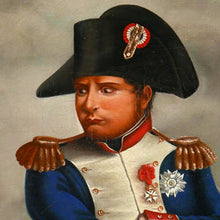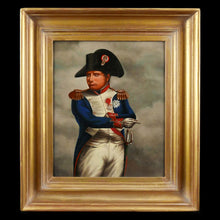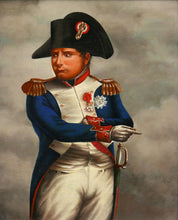The Emperor in Exile - A Portrait by Captain Charles Shaw, R.N., 1820
Adding product to your cart
Overall: 41cm (16in) x 36cm (14.2in)
Oil on canvas. Three-quarter length portrait of Napoleon Bonaparte looking right and pointing left with his right hand, attired in bicorne adorned with national cockade and uniform of the Garde Nationale, set against a background the swirling mist and clouds, reminiscent of climatic conditions at Longwood, his captive home on St. Helena. Signed verso ‘By Captn. Charles Shaw R.N.’ Contained in a period giltwood frame.
The creator of the present portrait, Charles Shaw, a Royal Navy officer and talented amateur artist, encountered Napoleon on the South Atlantic island of St Helena in August 1816. Shaw was the captain of the 18-gun sloop H.M.S. Termagent, which, homeward bound from Madras, called in to revictuall at St. Helena. By this point in Napoleon’s captivity relations with the island’s Governor, and his de facto gaoler, Sir Hudson Lowe, were at a point where they no longer met face to face. Lowe’s sixth and last interview with Napoleon was on 18 August 1816, after which the prisoner refused to meet him. The French were not alone in thinking Lowe a poor choice for the post on account of his punctilious and unimaginative nature and strict enforcement of the rules of confinement.
Read more
A letter of complaint to Lowe, known as 'The Montholon Remonstrance’, was penned on 24 August 1816. Accordingly it fell to Captain Shaw to carry Lowe’s despatches to Napoleon when he, together with Lieutenant John Louis, R.N. and Captain Gray, R.A., were invited to one of the interviews Napoleon customarily granted to visitors to help stave off boredom. The visit was seized on by the mini court surrounding Napoleon as an opportunity to try and manipulate public opinion in England over Napoleon’s alleged ill treatment at the hands of Lowe. To this end Captain Shaw was made aware of the Marquis de Montholon’s letter, as Surgeon Barry O’Meara recalled in his book ‘Napoleon in Exile, or A Voice From St. Helena (1822)’ - ‘[Comte] De Las Cases showed it to Capt Shaw of the Termagant, and, I believe, offered a copy to Capt. Gray of the Artillery, and Lt. Louis of the Northumberland, to whom a copy was also offered, which he refused taking, as Sir Hudson expressed his earnest wish to me that it should not be sent even to the Admiralty.’
The refusal of Shaw and his friends to promote the letter of complaint in England was undermined by O’Meara who smuggled a copy of this and other letters to John Finlaison, a clerk at the Admiralty in London. The letters commented on Napoleon's state of mind as a captive and the causes of his complaints against Lowe and the British Government. The aggravation and baiting however was on not solely on Lowe’s side, as Shaw later discovered.
‘Bonaparte one day observed a captain of the navy on his grounds looking at him he immediately asked [General Henri Gatien] Bertrand who this was and being told that he spoke French very well and had been a prisoner in France he thought it must be Captain Wallis of the Podargus formerly first lieutenant with Captain Wright who is supposed to have been murdered in the Temple. He instantly ordered that he should be sent off his grounds and never permitted to come there again. This instead of being Captain Wallis who was at the time forty miles to leeward of the island proved to be Captain Shaw of the Termagant. Buonaparte complained to Sir Hudson [Lowe] and said that Captain Wallis had insulted him and interrupted his walks and begged that in future no one should be allowed to enter his grounds without permission.’ (‘A Visit to Longwood’, Capt. Herbert John Clifford, R.N,, (1789-1855).
On his return to England Shaw memorialised his encounters with the former Master of Europe by producing the present portrait, as a momento for his family, the Best-Shaw baronets.
Captain Charles Shaw, R.N., (1785-1829) was born at Kenward Park, Kent, the second son of Sir John Gregory Shaw, 5th Baronet. He entered the Royal Navy as a 1st Class Volunteer at a young age. His letters home were peppered with requests for money to address his sartorial shortcomings - a common problem amongst Volunteers and Midshipmen reliant on their pay alone. ‘I cannot appear as an officer’, he complained to his parents, adding that he had been reprimanded for not having a cocked hat. In due course he passed the examination for Lieutenant and was commissioned on 8 April 1805. He was promoted Commander on 26 September 1811, and appointed to the command of the 18 gun brig-sloop HMS Philomel on the Mediterranean station until 1 July 1814. On 10 August 1812 he and Captain Peyton of the Minstrel blockaded three French privateers that had been hauled on shore and were protected by a makeshift battery of their own guns constructed on the beach at Benidorm. In the same year he ran a French privateer on shore near Valencia where she was burned by her crew to prevent him gaining possession. Shaw was advanced to Post Captain on 1 July 1814 in the East Indies, and returned to home waters via the Cape and St. Helena in H.M.S. Termagant. In October 1816 Shaw’s Officers, Seamen, and Royal Marines collectively contributed to the Waterloo Relief for the families of those who had fallen at the Battle of Waterloo. Shaw married on 13 April 1822 Frances Ann, fourth daughter of Sir Henry Hawley, 1st Baronet, and had four daughters and twin sons, the eldest, John Charles Kenward Shaw, succeeding to the Shaw baronetcy in 1831.








